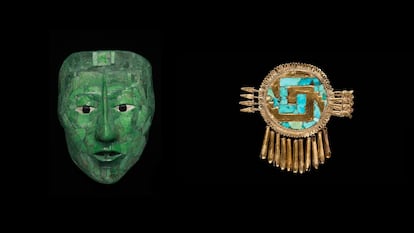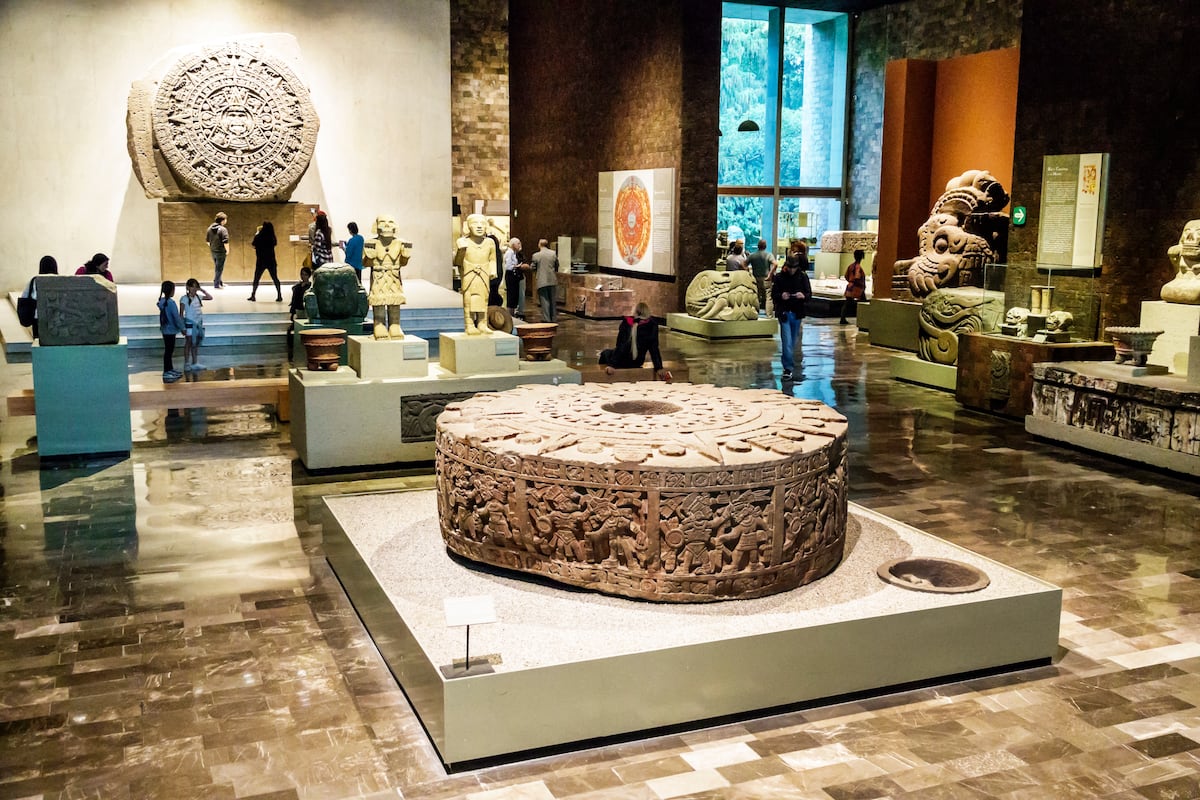Why would two young students rob the most important museum in Mexico? For mystery lovers, the promise of money after the sale isn’t enough of an explanation.
During the early hours of December 25, 1985 — while the Christmas holidays were being celebrated — Mexico City was the scene of one of the most shocking robberies in the history of the country. Two veterinary students from the National Autonomous University of Mexico (UNAM) broke into the National Museum of Anthropology (MNA) and stole 124 archeological pieces from the rooms dedicated to the Maya, Mixteca and Mexica civilizations. The theft — known as “the robbery of the century” in Mexico — exposed serious flaws in the security of the country’s cultural venues. And, despite the meticulous investigation that followed, it took the authorities almost four years to recover most of the pieces, which the thieves had managed to hide.
An unprecedented robbery
Carlos Perches Treviño and Ramón Sardina García — both 21-years-old — were veterinary students at UNAM. They belonged to middle-class families and had no criminal records. However, both Perches and Sardina shared a fascination with archeology and pre-Hispanic art. This made them obsessed with the National Museum of Anthropology, a central pillar in the conservation of Mexican heritage.
In 1985, the museum had been in operation for 21 years, located between Paseo de la Reforma — a major avenue — and Mahatma Gandhi Street, within Chapultepec Park in Mexico City. For six months, the young men observed the routines of the museum’s security personnel. They detected the weak points and the opportunities to carry out the robbery. They chose Christmas Eve of 1985 as the ideal time to act, knowing that surveillance would be minimal.
The robbery began at 1 a.m. on December 25, 1985, lasting until 4 a.m. The two young men entered the premises through the air conditioning ducts, avoiding security cameras and the alarm system. For three hours, Perches and Sardina broke into the museum’s display cases. The security personnel — who were supposed to patrol the 161,000 square feet of the 26 rooms every two hours — failed to do their job. They were all in one location of the museum, celebrating Christmas.
The 124 stolen pieces included objects from the sacred cenote of Chichén Itzá, more than 60 Mayan pieces from the Temple of Palenque, gold jewelry from the Mixteca room and the famous mask of the Zapotec Bat God, among others. According to Felipe Solís — curator of the National Institute of Anthropology and History (INAH) — the value of just one of these pieces on the black market exceeded $20 million at the time (about $58.5 million today). Still, the greatest damage was cultural, rather than monetary. “What they’ve stolen from us is a piece of our history… [something priceless] and of inestimable anthropological and historical value,” Solís lamented.
After the robbery, the two robbers fled in a Volkswagen and headed to Perches’ parents’ house, located in the Jardines de San Mateo suburb, on the outskirts of Mexico City. They hid the pieces in a suitcase that remained stored in the closet of Carlos’s room.
The investigation and the years that followed
The scandal became worldwide news. After the slow reaction of the Mexican government to the catastrophe of the earthquake of September 19, 1985, its reputation was at stake. Hence, the response to the theft was immediate. In addition to the cooperation of the immigration body, personnel from the General Directorate of Customs, workers from the country’s airports and Interpol, more than 30 people were tasked with solving the case. Due to the massive investigation, the thieves opted to keep a low profile, refraining from any attempt to sell the pieces on the black market.
The National Museum of Anthropology initially reported the theft of 140 pieces. Later on, however, the official catalog of the museum established that 124 objects were stolen. There was a discrepancy due to the absence of a precise inventory at the time of the theft. The stolen items included 94 gold objects and others made of jade, turquoise, green stone, shell and obsidian.
The investigation took a turn in January 1989, when police arrested drug trafficker Salvador Gutiérrez — alias “El Cabo” — in the Mexican city of Guadalajara. Gutiérrez — hoping to reduce his sentence — confessed that he knew the whereabouts of the stolen pieces and provided information about Carlos Perches, whom he had met in Acapulco. After the robbery, Perches took refuge in that city and established links with drug traffickers — such as José Serrano — who offered to help him try to sell the pieces on the black market.
Perches’ relationship with drug traffickers was key to his capture. Javier Coello Trejo — who, at the time, was a deputy prosecutor in the War on Drugs — told the newspaper Reforma that he placed wiretaps in prisons and kept track of all calls between Gutiérrez and Perches. In one conversation, they were negotiating the sale of gems from one of “the greatest art [collections] in Mexico.” This was a light at the end of the tunnel in the search to find Perches and capture him.
The recovery of the stolen works
On June 10, 1989, seven months after the investigation against Carlos Perches began, the police carried out an operation in the suburb of Jardines de San Mateo. There, they recovered 111 of the 124 stolen pieces. Three days later, Attorney General Enrique Álvarez del Castillo presented the pieces at a press conference. He explained that they had been found in the residence belonging to Perches’ parents, wrapped in toilet paper and stored in a duffel bag. It’s believed that most of the pieces remained there since the day of the robbery.
Of the 124 pieces, seven remained in the possession of Ramón Sardina, who remains at large to this day. Two others were exchanged by Perches for cocaine, while the remaining four were never located. Despite the difficulties in the investigation, the authorities managed to recover practically all of the most valuable pieces, including the mask of the Zapotec Bat God and the obsidian jar shaped like a monkey.

The thieves’ fate
Carlos Perches was arrested at the age of 24 and sentenced to 22 years in prison for robbery and drug-related crimes. During his interrogation, according to Javier Coello Trejo, Perches admitted to being the mastermind behind the robbery and revealed details about the whereabouts of the pieces. Coello Trejo recalled that, during conversations with Perches, he feigned admiration for his audacity, a tactic he used to gain the thief’s trust and obtain more information. “The key to an interrogation is to make the accused feel comfortable,” the deputy prosecutor explained to the media.
Coello Trejo himself said that, beyond the value of the works after a possible sale, he doesn’t know why the young men committed this particular crime. Their specific motivation remains unknown to this day.
Sardina remains at large, but it’s believed that the seven pieces he had in his possession never left the country. Other accomplices — such as Luis Perches, Carlos’ brother — were arrested and prosecuted for concealment. Isabel Camila Masiero — José Serrano’s lover — was also prosecuted for concealment and drug-related crimes.
The impact of the robbery
The robbery of the century changed the way museums are seen and thought of in Mexico. As a result, the National Museum of Anthropology implemented strict security measures, installed electronic alarms, a closed-circuit television system and increased the number of guards. On top of all this, the Penal Code was reformed to punish crimes against cultural heritage more severely.

When the recovered pieces finally returned to the museum’s display cases in June 1989 — almost four years after their theft — the event was presided over by the then-president Carlos Salinas de Gortari. The writer Gabriel García Márquez attended the ceremony, telling the newspaper El Universal that he was so intrigued by the case that he was thinking of writing a novel about the events. “I came here as a novelist, attracted by the mystery, to understand what happened to these jewels… how they were [hidden] in a closet, with their history, with their magic. [And I was fascinated with] the effort put into such an action, by the elements of the investigative body of the agency,” he explained.
García Márquez’s novel on the subject was never published. But the Mexican director Alonso Ruizpalacios did adapt one of the most important robberies in the history of Mexico to the big screen with his film Museum (2018), taking some creative liberties. Still, he maintained the question that continues to be asked to this day: why did they do it?
Sign up for our weekly newsletter to get more English-language news coverage from EL PAÍS USA Edition

